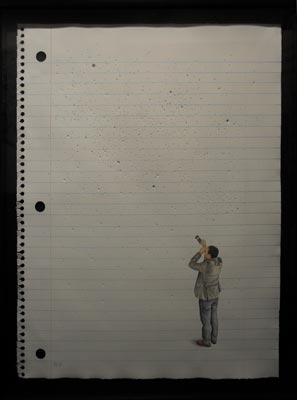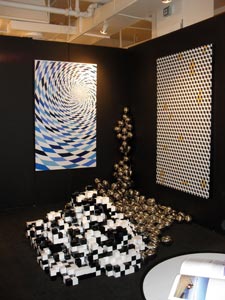(Beyond "Latin American art")
In recent years contemporary art fairs have shown an increasing ability to overcome the essence of their commercial status and become a first class aesthetic-cultural event, emulating the artistic quality of the biennial model, which is in evident decline. Proof of this is the evident rigor of the most recent editions of Balelatina, Art Basel, Art Forum, ARCO, Art Toronto, Art Moscow, FIAC Paris, Shanghai Art Fair, among others that have emerged as an honest thermometer of the complex dynamics of today’s artistic creation on a global.
 In this direction lies the last edition of PINTA New York (November 10-13, 2011), which reached its fifth anniversary (which was celebrated with a change of venue to the heart of Manhattan), and was attended by more than 50 galleries of consolidated international prestige. The first thing that stands out from this rendezvous is how absurd it is in regards to its context, its disinterest in the common dialogue places and social struggles that have burdened Latin American art. PINTA offers us on this occasion a fresh vision of plastic arts in our countries, devoid of those naive emancipation utopias that attempt to change the world by means of the presumed seismic and suggestive effect of a work of art. Each stand of this meeting seemed to say “no more” to the cries of daily hardships, an “enough” of complaints and mock confrontations. While some spectral voices still go around speaking of the “re-politicization of art”, like prehistoric fossils trying to come back to life, PINTA prefers lightness, banality, the fashion side of creation. PINTA pretends that all is well, that life is beautiful, and that there are no dictators or despotic governments, that art is happier in its autonomy. And that seems marvelous, because of its cynicism, for intensifying saturations, for enrolling in that nihilistic spirit which has so much in common with our times. Before society columns and political treatises, a visual massage. Before explicit protests, the tangent’s disturbing nature, the ostrich’s cunning strategy.
In this direction lies the last edition of PINTA New York (November 10-13, 2011), which reached its fifth anniversary (which was celebrated with a change of venue to the heart of Manhattan), and was attended by more than 50 galleries of consolidated international prestige. The first thing that stands out from this rendezvous is how absurd it is in regards to its context, its disinterest in the common dialogue places and social struggles that have burdened Latin American art. PINTA offers us on this occasion a fresh vision of plastic arts in our countries, devoid of those naive emancipation utopias that attempt to change the world by means of the presumed seismic and suggestive effect of a work of art. Each stand of this meeting seemed to say “no more” to the cries of daily hardships, an “enough” of complaints and mock confrontations. While some spectral voices still go around speaking of the “re-politicization of art”, like prehistoric fossils trying to come back to life, PINTA prefers lightness, banality, the fashion side of creation. PINTA pretends that all is well, that life is beautiful, and that there are no dictators or despotic governments, that art is happier in its autonomy. And that seems marvelous, because of its cynicism, for intensifying saturations, for enrolling in that nihilistic spirit which has so much in common with our times. Before society columns and political treatises, a visual massage. Before explicit protests, the tangent’s disturbing nature, the ostrich’s cunning strategy.
There are no stereotypes in the exhibited works, much less in what regards to the vulgarized topic of Latin American identity. Going around the stands over and over it was very difficult for me to think or speak in terms of “Latin American art”. The possible boundaries between this art, and European and American art today, to me are strongly blurred (which caused me no displeasure, quite the contrary). I was just able to think of a single Western art, homogenized and globalized to the most radical levels. Thus, the much bandied question of identity was shattered before my eyes, and I, who have always been so strongly Eurocentric and Western, could not be happier with this finding. Today, there are not few thinkers that from the field of philosophy have questioned whether it is still possible to maintain the concept of “Latin American art”. PINTA in all probability represents a convincing response to this question.
It was also pleasant for me to confirm once again how tuned in to the previously described orientation was a significant and dominant segment of present-day Cuban art (particularly the most novel). This parallelism talks about a potential for internationalization and of growing progressive values.
But going back to the previous idea, at first glance it might seem that this attitude of “no compromise” and aesthetic-hedonistic sublimation responds to a market concession, for the sake of reaching greater success in sales. However, I do not think this is so. If any type of art has always sold well, very well, that is political art. If any one phenomenon has attracted the eye of a significant majority of collectionism (institutional or private) it is the creator-authority power struggles, those poses of rebellion that, rather than a sincere attitude towards art and life, often are nothing more than simple and frivolous stage scenes and marketingmechanisms to attract attention at all costs through media and institutional show that entails the action of the censorious authorities. PINTA seems to be disgusted with all of this and doesn’t want to know anything about pamphlet and ethics’ simulations. And that’s a good enough reason to celebrate. How good it is that Latin American art this time is moving away from the historical victim complex (that one in which it was to be “defended” and “protected” from the West, from the castrating metropolis, from the unholy dictatorships...). PINTA mocks this insipid and hollow rhetoric.
 The galleries with the most representative proposals that advocate the thesis I defend were Athena Art Gallery and Celma Albuquerque Art Gallery (Brazil); Espace Meyer Zafra (France), GC Art Studio (Argentina); Lyle O. Reitzel Gallery (Dominican Republic); Salar Art Gallery (Bolivia); as well as Art Nouveau Gallery, Gary Nader Fine Art, Cecilia de Torres LTD, Dot FiftyOne Gallery, Durban Segnini Gallery, Frederick Seve Gallery Josee Bienvenu Gallery, Sammer Gallery LLC, and Hosfelt Gallery, all from the United States. From this list something symptomatic can be derived: the bulk of the most interesting Latin American art exhibitions came from the hand of galleries from countries that are not from that region: United States, France, etc.. Apparently the hegemonic cultural centers’ meddling in the context of Latin American art and its dynamics of legitimacy, does not necessarily result pernicious as many claim, but rather oxygenating, enriching (sometimes as an antidote to suffocating localism and provincialism).
The galleries with the most representative proposals that advocate the thesis I defend were Athena Art Gallery and Celma Albuquerque Art Gallery (Brazil); Espace Meyer Zafra (France), GC Art Studio (Argentina); Lyle O. Reitzel Gallery (Dominican Republic); Salar Art Gallery (Bolivia); as well as Art Nouveau Gallery, Gary Nader Fine Art, Cecilia de Torres LTD, Dot FiftyOne Gallery, Durban Segnini Gallery, Frederick Seve Gallery Josee Bienvenu Gallery, Sammer Gallery LLC, and Hosfelt Gallery, all from the United States. From this list something symptomatic can be derived: the bulk of the most interesting Latin American art exhibitions came from the hand of galleries from countries that are not from that region: United States, France, etc.. Apparently the hegemonic cultural centers’ meddling in the context of Latin American art and its dynamics of legitimacy, does not necessarily result pernicious as many claim, but rather oxygenating, enriching (sometimes as an antidote to suffocating localism and provincialism).
The most explored aesthetic aspects on this occasion were: optical-kinetic art, abstraction (geometric and expressionist), Pop, Minimalism, Arte Povera, and Neo-Expressionism. There was very little conceptualism and a lot of sensationalism. A result that could bother many, but that for me, I insist again, resulted quite encouraging. As for names of specific artists, remarkably outstanding was the work of: Liliana Porter, Mauro Giaconi, Manuel Merida, Jose Garcia Cordero, Gerard Ellis, Sonia Falcone, Gastón Ugalde, Carlos Medina, Rafael Barrios, Gustavo Diaz, Gabriela Machado, among others. But rather than stop and analyze specific works, I was interested in taking this edition of PINTA as an excuse or required subject to debate on the complex topics presented above. Can we speak today of “Latin American art”, or what is the same thing, of an “identity” of the plastic arts of this geographical region? Are there boundaries between this and the rest of the global artistic production, amidst the deterritorialization and the transnationalization of our days? Those are the incisive questions with which PINTA faces us in a blunt and piercing manner. Towards the discussion in relation to the possible answers I wanted to direct the attention of these petty lines, that arose empirically, without much previous thought, rather as the result of the journey of a young “Latino” enthusiast, getting to know New York for the first time, its fascinating cultural universe, museums, galleries, fairs, bars and nightclubs, saunas and sex shops... In the midst of that exhilarating touristic and aesthetic experience the seed of these ideas is placed. Please pardon me if I have been too passionate or effusive. Considering such an event it couldn’t be any other way. Trust me.
Havana, December 2011
Related Publications

How Harumi Yamaguchi invented the modern woman in Japan
March 16, 2022












